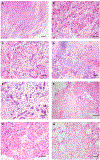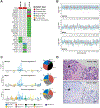Whole-exome sequencing and RNA sequencing analyses of acinic cell carcinomas of the breast
- PMID: 31361912
- PMCID: PMC6878125
- DOI: 10.1111/his.13962
Whole-exome sequencing and RNA sequencing analyses of acinic cell carcinomas of the breast
Abstract
Aims: Acinic cell carcinoma (ACC) of the breast is a rare histological form of triple-negative breast cancer (TNBC). Despite its unique histology, targeted sequencing analysis has failed to identify recurrent genetic alterations other than those found in common forms of TNBC. Here we subjected three breast ACCs to whole-exome and RNA sequencing to determine whether they would harbour a pathognomonic genetic alteration.
Methods and results: DNA and RNA samples from three breast ACCs were subjected to whole-exome sequencing and RNA-sequencing, respectively. Somatic mutations, copy number alterations, mutational signatures and fusion genes were determined with state-of-the-art bioinformatics methods. Our analyses revealed TP53 hotspot mutations associated with loss of heterozygosity of the wild-type allele in two cases. Mutations affecting homologous recombination DNA repair-related genes were found in two cases, and an MLH1 pathogenic germline variant was found in one case. In addition, copy number analysis revealed the presence of a somatic BRCA1 homozygous deletion and focal amplification of 12q14.3-12q21.1, encompassing MDM2, HMGA2, FRS2, and PTPRB. No oncogenic in-frame fusion transcript was identified in the three breast ACCs analysed.
Conclusions: No pathognomonic genetic alterations were detected in the breast ACCs analysed. These tumours have somatic genetic alterations similar to those of common forms of TNBC, and may show homologous recombination deficiency or microsatellite instability. These findings provide further insights into why breast ACCs, which are usually clinically indolent, may evolve into or in parallel with high-grade TNBC.
Keywords: DNA damage repair; acinic cell carcinoma; breast cancer; massively parallel sequencing.
© 2019 John Wiley & Sons Ltd.
Conflict of interest statement
Figures


Similar articles
-
The repertoire of somatic genetic alterations of acinic cell carcinomas of the breast: an exploratory, hypothesis-generating study.J Pathol. 2015 Oct;237(2):166-78. doi: 10.1002/path.4566. Epub 2015 Jul 29. J Pathol. 2015. PMID: 26011570 Free PMC article.
-
Genetic analysis of microglandular adenosis and acinic cell carcinomas of the breast provides evidence for the existence of a low-grade triple-negative breast neoplasia family.Mod Pathol. 2017 Jan;30(1):69-84. doi: 10.1038/modpathol.2016.161. Epub 2016 Oct 7. Mod Pathol. 2017. PMID: 27713419 Free PMC article.
-
Whole-exome analysis of metaplastic breast carcinomas with extensive osseous differentiation.Histopathology. 2020 Aug;77(2):321-326. doi: 10.1111/his.14088. Histopathology. 2020. PMID: 32043609 Free PMC article.
-
Problematic breast tumors reassessed in light of novel molecular data.Mod Pathol. 2021 Jan;34(Suppl 1):38-47. doi: 10.1038/s41379-020-00693-7. Epub 2020 Oct 6. Mod Pathol. 2021. PMID: 33024304 Free PMC article. Review.
-
Pancreatic acinar cell carcinoma is associated with BRCA2 germline mutations: a case report and literature review.Cancer Biol Ther. 2019;20(7):949-955. doi: 10.1080/15384047.2019.1595274. Epub 2019 Apr 19. Cancer Biol Ther. 2019. PMID: 31002019 Free PMC article. Review.
Cited by
-
Elucidating the nature of acinic cell carcinoma of the breast with high-grade morphology: evidence from case report.Diagn Pathol. 2024 Jul 24;19(1):100. doi: 10.1186/s13000-024-01521-1. Diagn Pathol. 2024. PMID: 39049123 Free PMC article.
-
High grade acinic cell carcinoma of the breast with clear cytoplasm mimics clear cell carcinoma in a BRCA1 mutation carrier: a case report and review of the literature on the molecular analysis.Histol Histopathol. 2023 Jan;38(1):91-97. doi: 10.14670/HH-18-501. Epub 2022 Jul 27. Histol Histopathol. 2023. PMID: 35894298 Review.
-
Protein tyrosine phosphatase, receptor type B is a potential biomarker and facilitates cervical cancer metastasis via epithelial-mesenchymal transition.Bioengineered. 2021 Dec;12(1):5739-5748. doi: 10.1080/21655979.2021.1968250. Bioengineered. 2021. PMID: 34516350 Free PMC article.
-
Clinicopathological, immunohistochemical and molecular features of acinic cell carcinoma of the breast.Oncol Lett. 2024 Jan 18;27(3):107. doi: 10.3892/ol.2024.14241. eCollection 2024 Mar. Oncol Lett. 2024. PMID: 38304172 Free PMC article.
-
Pathogenesis of Triple-Negative Breast Cancer.Annu Rev Pathol. 2022 Jan 24;17:181-204. doi: 10.1146/annurev-pathol-042420-093238. Annu Rev Pathol. 2022. PMID: 35073169 Free PMC article. Review.
References
-
- Roncaroli F, Lamovec J, Zidar A, Eusebi V. Acinic cell-like carcinoma of the breast. Virchows Arch 1996;429;69–74. - PubMed
-
- Lakhani SR, Ellis IO, Schnitt SJ, Tan PH, van de Vijver MJ. Who classification of breast tumors. IARC: Lyon, 2012.
MeSH terms
Substances
Grants and funding
LinkOut - more resources
Full Text Sources
Medical
Research Materials
Miscellaneous

